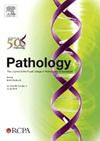金黄色葡萄球菌青霉素敏感性的表型方法比较。
IF 3
3区 医学
Q1 PATHOLOGY
引用次数: 0
摘要
本研究的目的是利用聚合酶链反应(PCR)作为参考,评估表型方法在金黄色葡萄球菌分离株中青霉素敏感性的表现。采用blaZ和mecA PCR将126株金黄色葡萄球菌分为青霉素敏感金黄色葡萄球菌(PSSA)、甲氧西林敏感金黄色葡萄球菌(MSSA)和耐甲氧西林金黄色葡萄球菌(MRSA)。采用微量肉汤稀释法(BMD)和琼脂稀释法(AD)测定各菌株对青霉素的最低抑菌浓度(MIC)。采用校准二法敏感性(CDS)、临床实验室标准协会(CLSI)和欧洲抗菌药物敏感性试验委员会(EUCAST)方法,采用盲法光盘扩散试验确定定性药敏。计算绝对吻合率(CA)、严重错误率(ME)和非常严重错误率(VME)。经分子鉴定,其中PSSA 66株,MSSA 38株,MRSA 22株。BMD和AD的VME发生率较高(9.6%),其中20%的耐青霉素金黄色葡萄球菌分离株青霉素MIC≤0.125 mg/L。使用椎间盘扩散法没有VME,三个独立的钢板阅读器的解释高度一致。CLSI的CA率为98.6%,ME率为1.4%;CDS的CA率为97.6%,ME率为2.4%;EUCAST的CA率为93.8%,ME率为6.2%。所有的方法在考虑了车牌读者的解读后都得到了改进。实验室可以根据使用CLSI、EUCAST或CDS方法的光盘扩散试验,自信地报告大多数临床金黄色葡萄球菌分离物的青霉素敏感性。独立钢板阅读器的共识报告可以改善椎间盘扩散检测的CA。青霉素MIC测定不应用于证明金黄色葡萄球菌分离株对青霉素的敏感性,除非经圆盘扩散或分子方法证实。本文章由计算机程序翻译,如有差异,请以英文原文为准。
A comparison of phenotypic methods to demonstrate penicillin susceptibility in Staphylococcus aureus
The aim of this study was to assess the performance of phenotypic methods to demonstrate penicillin susceptibility in Staphylococcus aureus isolates using polymerase chain reaction (PCR) as a reference. A total of 126 S. aureus isolates were categorised as penicillin-susceptible S. aureus (PSSA), methicillin-susceptible S. aureus (MSSA) and methicillin-resistant S. aureus (MRSA) using blaZ and mecA PCR. The minimum inhibitory concentration (MIC) of penicillin for each isolate was determined by broth microdilution (BMD) and agar dilution (AD) methods. Qualitative susceptibility was determined by blinded disc diffusion testing using Calibrated Dichotomous Sensitivity (CDS), Clinical Laboratory Standards Institute (CLSI) and the European Committee on Antimicrobial Susceptibility Testing (EUCAST) methods. Categorical agreement (CA) rate, major error (ME) rate and very major error (VME) rate were calculated. These isolates were characterised into 66 PSSA, 38 MSSA and 22 MRSA by molecular testing. High rates of VME (9.6%) were encountered using BMD and AD, with 20% of penicillin-resistant S. aureus isolates having a penicillin MIC ≤0.125 mg/L. There was no VME using disc diffusion methods with high level of agreement of interpretation by three separate plate readers. CA rate using CLSI was 98.6% with 1.4% ME rate, for CDS CA rate was 97.6% with 2.4% ME rate, and for EUCAST CA rate was 93.8% with 6.2% ME rate. All methods improved with consensus reporting after considering interpretation by the plate readers. Laboratories can confidently report penicillin susceptibility in the majority of clinical S. aureus isolates based on disc diffusion testing using CLSI, EUCAST or CDS methodologies. Consensus reporting by independent plate readers may improve CA of disc diffusion testing. Penicillin MIC determination should not be used to demonstrate penicillin susceptibly in S. aureus isolates without confirmation by disc diffusion or molecular methods.
求助全文
通过发布文献求助,成功后即可免费获取论文全文。
去求助
来源期刊

Pathology
医学-病理学
CiteScore
6.50
自引率
2.20%
发文量
459
审稿时长
54 days
期刊介绍:
Published by Elsevier from 2016
Pathology is the official journal of the Royal College of Pathologists of Australasia (RCPA). It is committed to publishing peer-reviewed, original articles related to the science of pathology in its broadest sense, including anatomical pathology, chemical pathology and biochemistry, cytopathology, experimental pathology, forensic pathology and morbid anatomy, genetics, haematology, immunology and immunopathology, microbiology and molecular pathology.
 求助内容:
求助内容: 应助结果提醒方式:
应助结果提醒方式:


